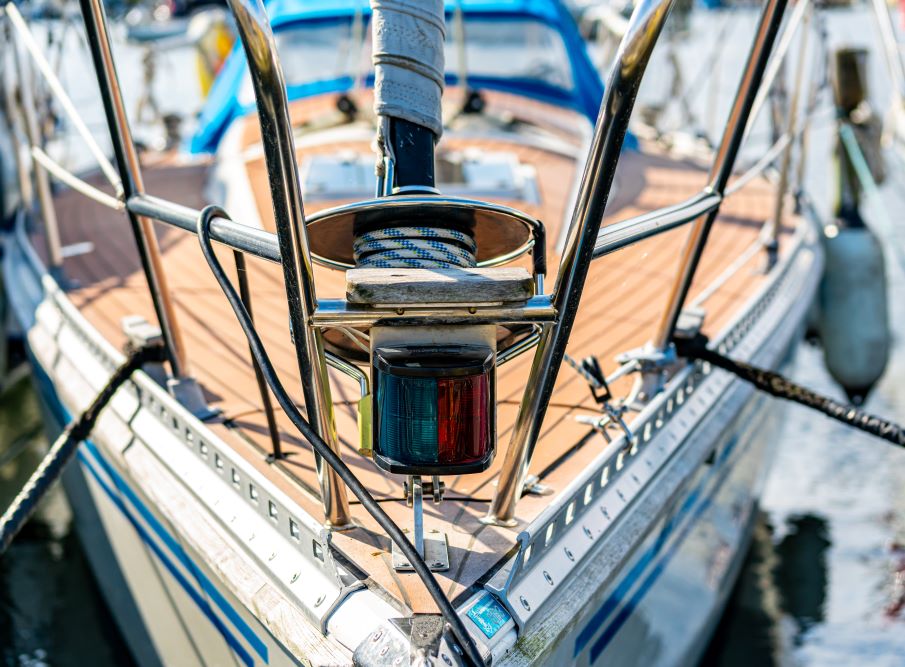
When to Use Navigation Lights
In boating, navigation lights are part of the safety equipment required on board a boat. The lights required vary depending on the size and type of boat.
Whether you are a pleasure boater or a professional, you need to know how to display the correct navigation lights at the right time.
Main types of navigation lights
For more information on equipment requirements, please refer to our article on boating safety equipment.
There are four main types of navigation lights for pleasure boats in Canada.
1. Masthead light
This white light is mounted on the front part of a vessel’s mast, above the sidelights. It projects uninterrupted light forward across the horizon in a 225° arc.
2. Sidelights
Sidelights consist of a red light on the port side and a green light on the starboard side, as close to the bow (the front of the boat) as possible. Each projects uninterrupted light across the horizon in a 112.5° arc.
Sidelights can be combined in a single lantern placed at the front tip of the boat’s longitudinal axis.
3. Sternlight
This white light is placed as close as possible to stern, and projects uninterrupted light backward across the horizon in a 135° arc.
4. All-round white light
As its name suggests, this navigation light projects uninterrupted white light across the horizon in a 360° arc. It is usually placed at the stern of the boat.
Other navigation lights
Other navigation lights that are less commonly used by pleasure boaters include:
Towing light
The towing light is a yellow light placed as close to the stern as possible. It projects uninterrupted light backwards across the horizon in a 135° arc.
Flashing light
A regular flashing light flashes at a frequency of 120 or more times per minute.
Special flashing light
A special flashing light is a yellow light that flashes at a lower frequency than a regular flashing light. This navigation light flashes at regular intervals at a frequency of 50 to 70 times per minute. It is placed as close as possible to the front of the tug or boat being towed.
Blue flashing light
The blue flashing light is a blue light that is visible all around the horizon, flashing at regular intervals at a frequency of 50 to 70 times per minute. This type of navigation light is mainly used by boats that belong to the state or police.
If a police boat approaches your vessel with a blue flashing light, you must stop and wait for it to reach you.
When to use navigation lights
Generally, the purpose of navigation lights is to make it easier to see and be seen by other boats.
They can also help determine which vessel has the right of way in crossing situations, because they provide information on the type and status of the boat in question (anchored, fishing, towing, being towed, etc.) That’s why navigation lights are mandatory under the Collision Regulations.
Vessels must use their navigation lights when operating in the evening after sunset or early in the morning before sunrise.
Navigation lights must also be used during the day when visibility is restricted or reduced. Fog, heavy rain and snow are examples of conditions that can reduce visibility.
Recognizing different types of vessels based on navigation lights
As mentioned above, when you encounter a boat at night or in reduced visibility, navigation lights can help you identify what type of vessel it is.
Motorboats under 7 metres long
While its speed doesn’t exceed 7 knots, motorboats of this size must at least be equipped with an all-round light.
Motorboats under 12 metres long
While underway, motorboats of this size must display sidelights and an all-round light.
Motorboats over 12 metres long
While underway, motorboats of this size must display sidelights, a masthead light and a sternlight.
Sailboats
While underway, a sailboat must display sidelights and a sternlight. However, if the sailboat is less than 20 metres long, these lights may be combined at the top of the mast.
Sailboats under 7 metres long
Sailboats under 7 metres long may sail without lights, but must be prepared to signal their presence with an electric flashlight or lighted lantern showing a white light. The same rule applies for canoes and kayaks.
Visibility range requirements for navigation lights
Navigation lights must possess a sufficient range of visibility to comply with regulations.
|
Vessel Length |
Navigation Lights: Range |
| Under 12 metres | 2 miles (except for sidelights, which only need to be visible within 1 mile) |
| Between 12 and 50 metres | 2 miles (except for the masthead light, which must be visible within a 5-mile radius, or for 3 miles for boats under 20 metres) |
What happens if you do not display your navigation lights correctly?
If you don’t use your lights or fail to use the correct lights when the situation requires, you could be fined.
If you fail to comply with navigation light regulations and cause an accident as a result, you could suffer serious legal consequences and be held liable for damages or injury under the civil code.
Learn all about boating safety from the National Boating Safety School
Your safety on the water depends on using navigation lights correctly when it is dark or when visibility is reduced for other reasons like bad weather. Make sure you know when to turn them on and how to interpret the signals from other boats before going out on the water.
Want to learn more about boating safety and pleasure boating? The National Boating Safety School is your best resource. tour online course helps you prepare for the Transport Canada approved boating exam. Once you pass, you will receive your Pleasure Craft Operator Card, which allows you to legally operate a boat in Canadian waters.


